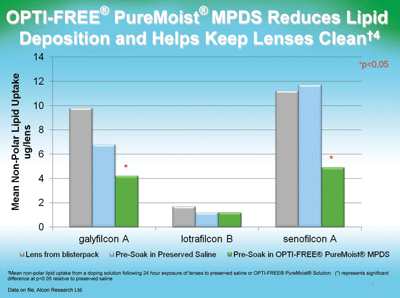Delivering a superior contact lens wearing experience hinges primarily on consistency of comfort. Whether the lens is replaced biweekly or monthly, patients desire and expect clear comfortable vision throughout the day as well as throughout the wear cycle. The deposition of contact lenses with substances derived from the tear fluid is a well-known clinical complication, resulting in reductions in comfort, vision and increased inflammatory responses.1 Thus, reducing surface deposits is a key factor in promoting both healthy and comfortable contact lens wear. Instructing patients to clean their lenses each night prior to storing is a critical element. Yet, despite our best efforts compliance remains elusive.
 So what else can we do? The answer lies in recognizing that the lens care system we recommend can play an equally important role. A multipurpose disinfecting solution, such as OPTI-FREE® PureMoist® MPDS, formulated to effectively remove protein deposits and reduce lipid deposition can prove an invaluable component to foster consistently clean lenses and all day comfort.
So what else can we do? The answer lies in recognizing that the lens care system we recommend can play an equally important role. A multipurpose disinfecting solution, such as OPTI-FREE® PureMoist® MPDS, formulated to effectively remove protein deposits and reduce lipid deposition can prove an invaluable component to foster consistently clean lenses and all day comfort.
The migration of siloxane moieties to the material surface may result in the production of the hydrophobic surfaces of some silicone hydrogel lenses and, in turn, the marked lipid deposition. OPTI-FREE® PureMoist® MPDS with HydraGlyde® Moisture Matrix minimizes the hydrophobic nature of silicone hydrogel lenses, thereby improving the surface wettability.2 HydraGlyde Moisture Matrix contains a block copolymer, EOBO (polyoxyethylene polyoxybutylene), which boasts excellent affinity for both internal and external siloxane groups enabling it to competitively “block” the dry spots to which lipids can attach.
A study was conducted comparing lipid uptake among commonly prescribed silicone hydrogel materials after a 24-hour soak in either preserved saline or OPTI-FREE® PureMoist® MPDS.3 Significantly fewer lipids were extracted from two of the three brands after soaking in OPTI-FREE® PureMoist® MPDS, than lenses soaked in the preserved saline. Thus, the seemingly passive step of lens soaking and storage can, indeed, prove to be an active defense against lens surface deposition.
When prescribing silicone hydrogel contact lenses, “go on the offensive” and recommend a care system to optimize lens performance. If the best defense against reduced comfort and patient drop out are consistently clean, wet lenses, then your patients and your practice may benefit from using OPTI-FREE® PureMoist® Matrix MPDS with HydraGlyde Moisture.
1. Jones, L., Senchyna, M., Glasier, M. et al. Lysozyme and Lipid Deposition on Silicone Hydrogel Contact Lens Materials. Eye & Contact Lens 2003; 29(1). S75-S79
2. Davis J, Ketelson HA, Shows A, Meadows DL. A lens care solution designed for wetting silicone hydrogel material. Poster presented at: ARVO; May 2010; Fort Lauderdale, FL.
3. Senchyna M, Stauffer P, Davis J, et al. Characterization of a multi-purpose lens solution designed for silicone hydrogel materials. Poster presented at ARVO 2010. Data on file, Alcon Research Ltd.
4. Data on file, Alcon Research Ltd, 2011.


